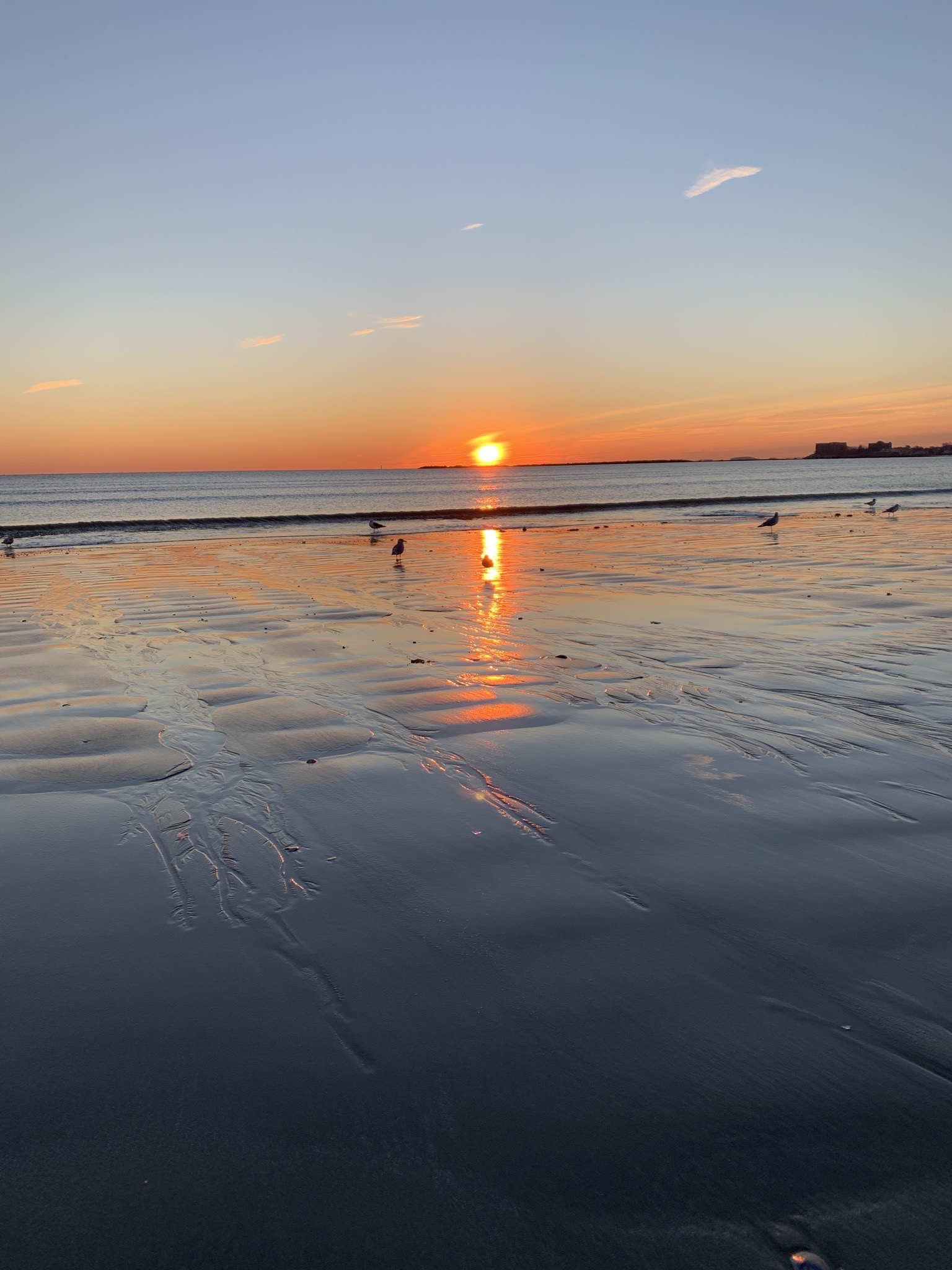Solstice
 Sunrise at Revere Beach, December 2021
Sunrise at Revere Beach, December 2021
I finally saw the round tip of the cold December sun above Massachusetts Bay. It inched upwards towards the pristine sky that it had already illuminated from beneath the horizon, coloring the space in its vicinity bright orange. As it rose slowly and steadily, the gold carpet with yellow and red fringes that it laid down on the ocean and the beach stretched farther and wider, wavering and shimmering as the sea flowed and ebbed.
My body was shivering under four layers of clothes and a down jacket while I held my girlfriend’s hand in my pocket. We stood on the frozen beach, watching the sun rise on the shortest day of the year. Behind us to the west, a waning crescent moon was setting after keeping vigil for a long night. Having slept for only a few hours, we were extremely tired, but the scene was well worth leaving the comfort behind. After a long night of rest, would the sun be as tired as us?
Before visiting my girlfriend in Boston, I was planning with her what we could do together. I had always liked the solstices and equinoxes. They were perhaps my favorite holidays because they derive their meanings and dates from nature. They have been observed universally around the world since antiquity. The five-millennium old Stonehenge in southern England was constructed to align with the direction of the sunrise on the summer and winter solstices. Newgrange, an even older monument than the Stonehenge located in Ireland, is also aligned with the winter solstice sunrise. Thus observing them was a way for me to continue this old tradition.
So I proposed to see the sunrise on the winter solstice. She said she had the same idea and knew a good spot. Our initial plan was to stay up the entire night before the sunrise and chat until the wee hours. We wanted to relive the time when we talked through the night until the sun rose a few years before. However, that happened close to the summer solstice: the night was short and the day was long. We ended up staying up until two or three in the morning, but neither of us could stay awake any longer. We gave up on the effort and slammed our bodies into the bed and fell asleep quickly.
Just a few hours later, the alarm she set went off and aroused us. It was five. I was so tired and wanted to sleep so badly that I considered abandoning the plan. I caressed her back and said, “Let’s just sleep a bit longer.” She was more adamant on the mission than I was. After dozing off for about fifteen minutes, she convinced me to go. I mustered all my strength to get up and leave the warmth of the bed behind. We bundled up and left the room.
Boston was still asleep in the near darkness. The normally bustling Newbury Street was peaceful and quiet. Few people were out wandering about like us, and once in a while a car drove by. We walked to Hynes Convention Center Station to take the Green Line. She led. I followed. The subway was almost empty. I saw the sky slowly becoming brighter as she napped on my shoulder. We transferred to the Blue Line at Government Center Station and arrived at our destination after half an hour or so.
“Reverie Beach” I read the station name on the sign out loud. “What a lovely name.” I thought. Later I realized that it was actually “Revere Beach,” named after the Bostonian patriot during the American Revolution, Paul Revere. Anyhow, I still think Reverie beach is a more thoughtful name.
The beach was easily accessible from the subway station. We walked a short distance and could already see the shoreline. The sand mixed with the seawater was frozen, so the beach appeared like a large, wavy mirror, smooth and slippery. A flock of seagulls was having breakfast. The stronger, faster ones picked up clams from the shallow part of the water with their pliers-like beaks, flew high up to the sky, and dropped the helpless clams onto the hard, frozen sand. The clams would crack open, exposing the pink flesh and fluid inside. The seagull then dived downwards, landed near its prey, and started to enjoy its meal. The weaker, smaller ones would wait until the big seagulls were done eating, and then scavenge for leftover meat. A few daring ones would try to snatch a piece of meat while the hunter was devouring its meal. Annoyed, it would squawk at them and flap its wide wings to chase the thieves away. Alas. The hungry ones had no choice but to wait more patiently.
The fierce seagulls even scared us. We never knew where the clams would land. I felt like we were shelled by bombers. The thud that the clams made as they crashed onto the sand was alarming. It could probably crack a skull. One landed a few feet away from where we stood, and we quickly walked away to give the seagull more privacy.
The sun had risen completely above the bay. Layer by layer, the sky turned from red to orange to pink to yellow to blue. An airplane flew southbound, descending towards Logan International Airport. Did the passengers on board have a chance to see the sunrise and appreciate the moment? The sun rose higher, and we dragged our weary bodies back to the hotel room. When we got back downtown, the city was just awakening, but it was time for us to sleep.
The winter solstice is a day of hope. Despite the dark long night and the cold air, we knew the day was lengthening from this point onward. We held each other tight under the tender sun, feeling each other’s warmth, staying hopeful and joyful.